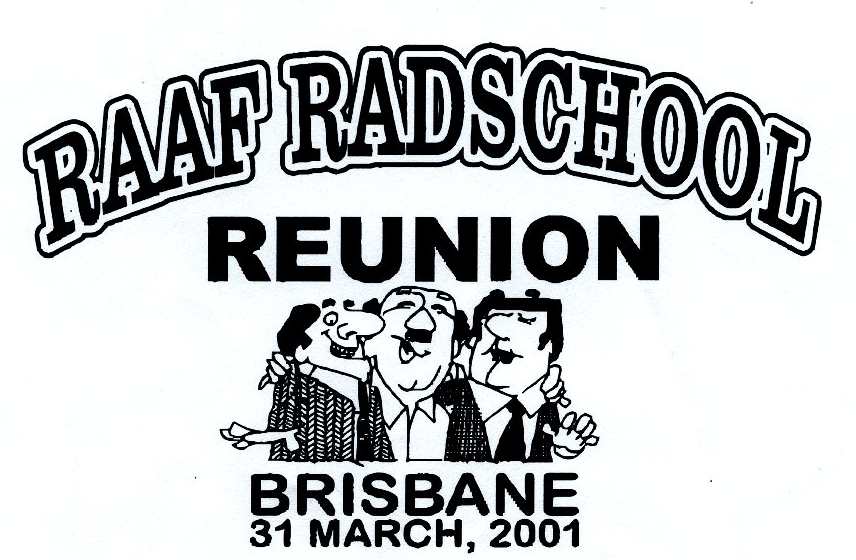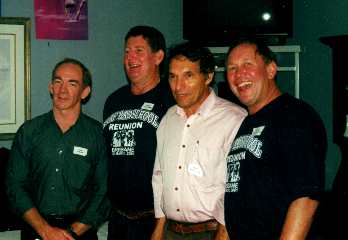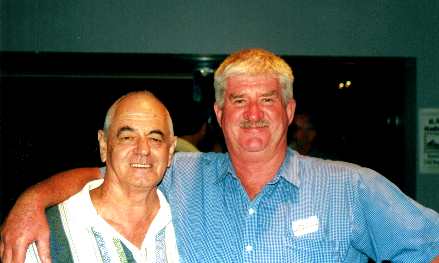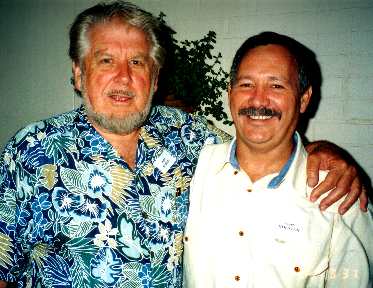|
|
||
|
|
Radschool Newsletter |
Vol 9 Page 8 |
|
|
||
|
Wines and Stuff. John Morley.
|
||
|
Port.
After a hearty meal with friends, what better way to finish the evening off that with a good Port, but, what is a port….
A Port is a "fortified wine". Brandy is added to the wine part of the way through the fermentation process to stop fermentation before the yeasts eat all the grape sugar, thus yielding a sweeter wine, which is also has a higher alcohol content. True Port comes from Portugal (the Duouro region, to be exact), but since winemakers in other countries have long ago taken to producing "Port," Duouro Port makers have started to call their Port, "Porto," or "Oporto" (from the city in Duouro). There are two main categories of Port:
Vintage Port
Only
when a winery decides that the year’s harvest (the vintage) is
exceptional will they decide to produce a Vintage Port. Grapes from
that year will be crushed and the wine stored in wood for at least 2
years. It is then bottled and stored again, and will also continue
to mature once bottled. Not only are not all years declared to be
vintage years, but not all wineries may decide within a particular
year that their wine is a vintage port, and even in a declared year
(which may occur two or three times in a decade) perhaps only 10% of
the grapes will go into vintage port (with the balance going to wood
ports). So in most years there just is no vintage Port at all!
Vintage Ports get much better with age and generally shouldn’t be drunk under 15 years. Some can keep getting better for a long time after that, even up to 100 years. Like most good wine, a vintage port shouldn't be left around undrunk once opened. (I know a bloke in Canberra who throws away the cork once opened—great ideal. tb)
Single Quinta Vintage Port:
This is true vintage Port from one harvest year bottled unblended after two years in cask. When a shipper "declares a vintage", the vintage Port from that year usually comes from wines produced by grapes from various vineyards (quintas). It is said that no one vineyard has all the characteristics to make the best vintage Port, it needs to be blended with other vineyards to be the most complete and complex wine. However, sometimes a producer's single best vineyard will yield grapes fine enough to warrant bottling on their own, while the rest of the vineyards that would normally contribute to a vintage Port weren't as successful. The producer may then choose to vinify this wine from that single vineyard, or "quinta". This is called "single-quinta vintage Port" and the quinta name will appear on the label. So, whereas a Port labelled "Willowvale's 1991 Vintage Porto" is a vintage Port from a declared year, "Willowvale’s Tentefield 1988 Vintage Porto" is a single-quinta vintage Port from Tenterfield, the best vineyard that Willowvale owns.
Wood Port.
Within this category are three sub-categories, based on colour, they are:
Ruby Port .
A dark red, somewhat sweet "full-bodied" wine which has probably been aged in wood for several years.
Tawny Port.
Not such a deep colour, it is a "smoother," less sweet wine which may have been aged in wood for 20 years. The difference between tawny Port and ruby Port is simply the amount of time that the wine spends in the wood cask before it is blended and bottled. As the wine ages, the ruby-red colour of the young wine becomes paler and browner. Top tawny Ports from the best producers are just as complex and fine (and expensive) as vintage Port, though they will have a different character. (If you find something labelled tawny Port which seems inexpensive, you may have found something produced by blending "tawny" Port with "white" Port. Needless to say, you'll tell the difference and Port connoisseurs will tell you that they aren't worthy of the name "Port" at all.)
White Port.
A sweet white wine made from white grapes grown in the Oporto region of Portugal. As with red Port, fermentation is stopped by adding brandy to the partly fermented wine. Not really like the other (red) Ports, which are usually drunk after a meal, this is usually drunk before a meal. Wood Ports will not get any better by cellaring, so you can drink them as you buy.
Decanting Port.
As you age your good Port it is going to "throw off" a good amount of sediment which is going to end up in your glass if you don't decant. So, get into the habit of decanting, unless you like to eat sediment, of course.
As with all wines, if you like it, buy it.
If you want any info on Willowvale wines, or should you wish to order any of their award winning wines, go to the Willowvale web site:- www.willowvalewines.com.au/products
|
||
|
Bloke said to the Doctor, “Doctor I’ve just swallowed a pillow” “How do you feel?” said the doctor. “Down in the mouth” said the bloke. |
||
|
|
||
|
Fix it?
A few of us were reminiscing one Saturday night, not so long ago, over dinner and a bottle (or 2) of red, and we agreed that even though a lot of us didn’t carry on in the electronics game that we’d learnt in the RAAF, the one legacy we do carry from our time in, is the ability to be able to “Fix Things.” And, after giving it a bit more thought the following day, away from the influence of the red, we reckon it’s true, yet I bet none of us realise just how useful that ability has been. To us it’s just natural, if something breaks down you simply rip it apart to find out why. If you want a new power point or a light in the next room, you just put it in, if the washing machine gives up the ghost, you automatically diagnose the fault and then fix it. It’s funny when you come across someone who doesn’t know how to “do things”, because we think if we can do it, so can everybody. Can’t everyone fix the stove, the car, the kids’ bikes, the lawn mower, what’s so hard about wiring up a stereo or a computer or programming a VCR or a micro-wave oven, can’t every-one use a multi-meter.
Thank you Mr Air Force……..
|
||
|
T-Shirts.
The blue T-shirts produced for the reunion were a hit, and most ordered one or more, and wore their shirts sometime during the week-end. We did say that we could get more for people that either didn’t initially order, or who wanted addition shirts, however, with the problems we had recently, we’ve let that lapse too so, unfortunately, we can’t get any more. Those blokes that sent in cheques for additional shirts will find a refund with their copy of the newsletter. Once again—sorry...
|
||
|
|
||
|
|
||
|
|
||
|
Bill Coyer and Trevor Benneworth at the recent reunion dinner in Brisbane. Bill and wife Win made the trip down from Darwin for the reunion where they’ve been since Tracey. Bill was a Cpl at 38 Sqn radio during the late 60’s, early 70’s, and was an avid participant of the Wednesday arvo “sporty” usually held at the Richmond RSL “gym”. And being a Cpl, if Bill said “come with me,” well, you had no option but to do as you were told.
Kev Carroll must have thought he had a very fit and healthy radio section in those days.
|
||
|
|
||
|
John Harris and Terry Houston at the reunion dinner. With all the man to man hugging going on (above 2 photos) perhaps one could be excused for asking “Just what sort of a do was it??”
|
||
|
A dietician was once addressed a large audience in Brisbane.
"Years ago, the material we put into our stomachs today is enough to have killed most of us sitting here” he said. “Red meat is awful, soft drinks erode the stomach lining, Chinese food is loaded with MSG, and few of us realize the long-term harm caused by the pollutants in our drinking water. But there is one thing that is the most dangerous food of all. Can anyone here tell me what food it is that causes the most grief and suffering for years after eating it?"
A 75-year-old man in the front row stood up and said,
"Yeah!...Wedding cake." |
||
|
|
||
|
|
||





